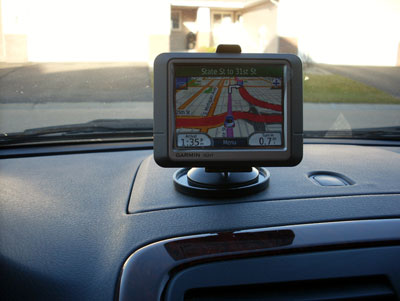Won’t leave home without GPS
Traveling in France, Spain and Portugal for over a month in September-October ’09, we found that using a GPS is a time/lifesaver. What an invention! No more having the wife trying to read a map or screaming at each other over missed turns.
“In one mile, enter roundabout”… “In 500 feet, enter roundabout and take third exit”… “Enter roundabout and take third exit, then turn right”… “Turn right and drive for five miles.” I’m sure you get the picture. We say, ‘Don’t leave home without it,’ and we never will again.
When leasing our car, it was recommended we use a TomTom GO 920 or a Garmin nüvi 270 while in Europe. GPS units of several types are available at many retail outlets, including Wal-Mart, Target and K-Mart. Most cover only the US or US/Canada/Mexico, but we were looking for one that included Europe at a reasonable cost. After considerable searching, we found the Garmin nüvi 270 through Amazon.com and it did everything we had hoped for.
Settings could be made to read, direct and speak in either metric or American standard (miles/feet) and in any of several languages. The volume and screen brightness were adjustable, and a lady’s clear, pleasant voice spoke the directions. We affectionately named her Carmen.
On-screen information told us how fast we were going, how far we had to go to our destination and what time we would arrive there. Settings included a “beep beep” warning that would go off if we entered a safety-camera zone or if there was a mobile speed camera working in the area, in which case it would also announce our speed.
We found that Carmen avoided “no driving” areas and would not direct us the wrong way on a one-way street. If we made a wrong turn, she got us back on track. When the road split ahead, she alerted us as to which side to take.
We love to travel freely and explore independently. If we were looking for a hotel, ATM, gas station, restaurant, etc., Carmen would list some nearby and we could just select one and she’d take us there. This was handy in the countryside when we realized we were low on fuel. We pressed the “fuel” icon and it listed gas stations all around us.
Same with hotels — when it neared 4 or 5 p.m., we would punch on the “lodging” icon and the names of several hotels would come up. It gave only the name and address of each plus the distance and direction from where we were, but we often found three or more hotels at the same proximity, giving us a choice. Carmen then would lead us right to the front door.
The GPS did have a little problem in narrow village streets with tall stone buildings and would lose its satellite link in long tunnels.
The Garmin maps and software we used covered the US, Canada and all of Western Europe. For Eastern Europe the coverage was limited to the major urban areas and in some countries just the major road systems.
We got a great deal through Amazon.com, buying the Garmin nüvi 270 new for $139 with free shipping (retail, it’s $319). This little instrument has a 3½-inch screen, which we found to be quite adequate. If you want a larger screen and the Europe coverage, it can drive the price up to $400-$500.
A 12V power plug that fit into the auto cigarette lighter was provided. An optional wall-outlet charging cord is available at Radio Shack for around $20.
Hookup was easy. The unit comes with a circular plastic base that sticks to the dashboard; a holder fits onto the base and the GPS unit clips into the top of that. Thus, the unit could also be used as a personal GPS in our pocket to guide us through the streets while on a walking tour.
EMILIA & DUANE
ANDERSON, Albertville, MN

